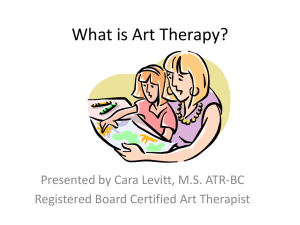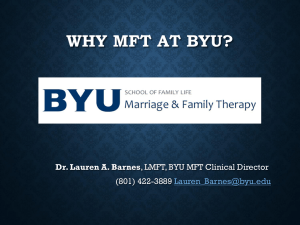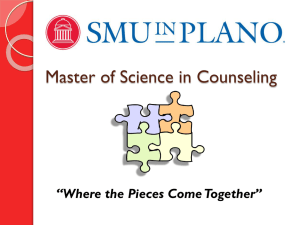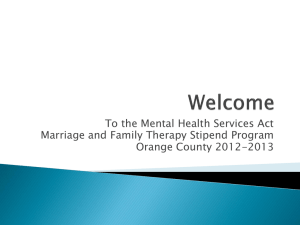A brief history of Art Therapy
advertisement
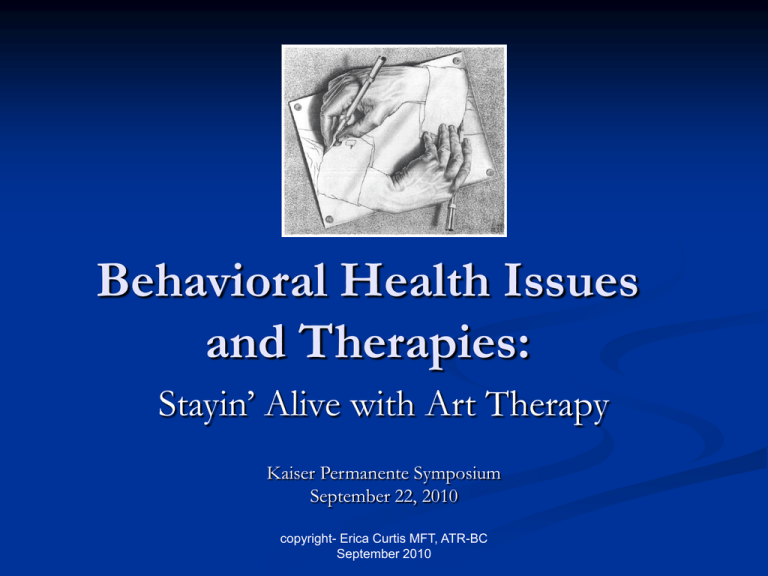
Behavioral Health Issues and Therapies: Stayin’ Alive with Art Therapy Kaiser Permanente Symposium September 22, 2010 copyright- Erica Curtis MFT, ATR-BC September 2010 Outline History of art therapy Art Therapy Theory Art as therapy vs. art in therapy Media & directives Impact and benefits Art Therapy Practice Beginnings Development of a profession Addressing specific populations Goal and interventions Conclusion Resources copyright- Erica Curtis MFT, ATR-BC September 2010 A brief history of Art Therapy What is art therapy & what is it not Who is an art therapist? ATR / ATR-BC / licensed MFTs / LCSWs Where it all started & where we are now A profession is born – 1940s Development of art based assessment copyright- Erica Curtis MFT, ATR-BC September 2010 Artistic Development: Lowenfeld’s Stages Scribble (14m-2y) Preschematic (3/4-6) Schematic (7-9) Dawning Realism (aka gang stage) (9-11) Psuedorealism (11-13) copyright- Erica Curtis MFT, ATR-BC September 2010 Period of Decision (14-16) Media Structured Loose copyright- Erica Curtis MFT, ATR-BC September 2010 Listening with your Eyes Look at process & product Look for metaphor Look for self symbols Look for the unexpected Look for the “subtext” Look for a narrative Look at art elements Look for your gut reaction Look at use & type of media Look for personal & cultural associations Look for changes over time Look for developmental level Look for warning signs copyright- Erica Curtis MFT, ATR-BC September 2010 Art as therapy / Art in therapy . . . Impact and benefits master manipulators of language different learning styles left vs. right brain focus indirect vs. direct experience intensity of relationship just not having the words cognitive level capacity for insight talk “resistant” language delays window in unconscious / preverbal /emotional brain window in neurological functioning copyright- Erica Curtis MFT, ATR-BC September 2010 “Clients perceived that they had experienced a significant decrease in denial of their addiction during treatment and rated collage making . . . as important to their First Step work” “Art therapy appeared to promote more cooperative behavior [in children with leukemia during painful interventions]” Orton, M. (1994). A case study of an adolescent mother grieving the death of her child due to Sudden Infant Death Syndrome. American Journal of Art Therapy, 33(2), 37-44). “Following the intervention, the participating group showed significantly improved measures of self-esteem, and reduced depression and anxiety at posttest” Anschel, D.J., Dolce, S., Schwartzman, A.,& Fisher, R.S. (2005). A blinded pilot study of artwork in a comprehensive epilepsy center population. Epilepsy &Behavior Journal, 6(2), 196-202. “The Grief Scale showed improvement in areas of sadness, guilt, humor, and hopefulness” Gabriel, B., Bromberg, E., Vandenbovenkamp, J., Walka, P., Kornblith, A., & Luzzatto, P. (2001). Art therapy with adult bone marrow transplant patients in isolation: A pilot study. Journal of Psycho-Oncology, 10(2), 114-123. “The Formal Elements Art Therapy Scale task showed significant effects in patients with epileptic seizures . . . and provides a basis for the future development of diagnostic tests to be used within this patient group” Favara-Scacco, D., Smirne, G., Schiliro, G., & Di Cataldo, A. (2001). Art therapy as support for children with leukemia during painful procedures. Medical Pediatric Oncology, 36 (4), 478-480. “The non-verbal metaphorical modality of art therapy may be especially beneficial for patients who need to deal with emotional conflicts, and with feelings about life and death, in a safe setting” Julliard, K. (1995). Increasing chemically dependent patients’ belief in Step One through expressive therapy. American Journal of Art Therapy, 33(4), 110-119. Doric-Henry, L. (1997). Pottery as art therapy with elderly nursing home residents. Art Therapy: Journal of the American Art Therapy Association, 14(3), 163-171. “Mothers reported higher levels of self-esteem and a more positive self-image following treatment” Ponteri, A., K. (2001). The effect of group art therapy on depressed mothers and their children. Art Therapy: Journal of the American Art Therapy Association, 18(3), 148-157. copyright- Erica Curtis MFT, ATR-BC September 2010 Populations Abuse ADHD Asperger’s / Autism Aging, Elderly, Geriatric Caretakers Chemical Dependency / Substance Abuse Grief / Bereavement Learning disabilities Medical Mentally Retarded / Developmentally Delayed Normal & Outpatient Phase of life / transitions Pre and Postnatal Post Traumatic Stress Disorder & Trauma Prison / Incarceration Psychiatric Relationship Issues School / Academic Traumatic Brain Injury You, me, them, and us . . . copyright- Erica Curtis MFT, ATR-BC September 2010 What is your goal? “Using their skills in evaluation and psychotherapy, art therapists choose materials and interventions appropriate to their clients’ needs and design sessions to achieve therapeutic goals and objectives.” Assessing developmental level, progress, insight, etc. Attunement with self / others Building Mastery Catharsis Clarifying/teaching feelings Commemorating / Remembering Creating new narratives Describing experience Distraction Experimenting with new behaviors Expressing impulses safely Facilitating identity development Generating alternatives Gratification delay Improving self-observation Increasing attention & frustration tolerance Pain assessment / Pain relief Supporting creative strengths / characteristics Taking risks Teaching stress relieving tools copyright- Erica Curtis MFT, ATR-BC September 2010 Online Art Therapy Resources www.arttherapy.org www.atcb.org www.SoCalArtTherapy.org copyright- Erica Curtis MFT, ATR-BC September 2010

